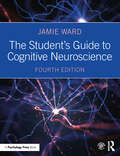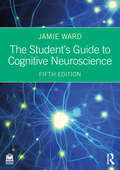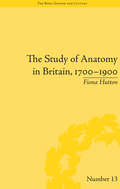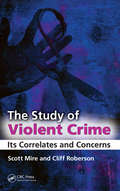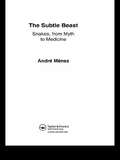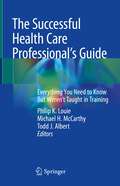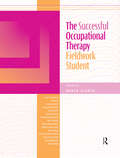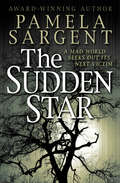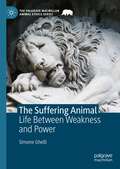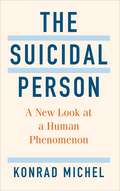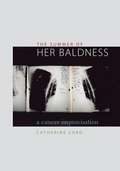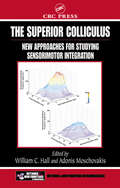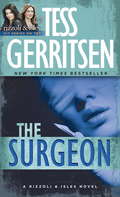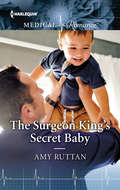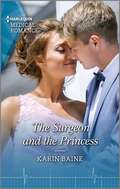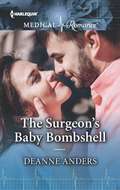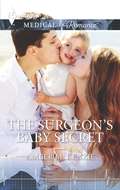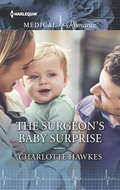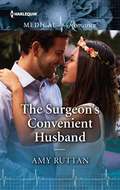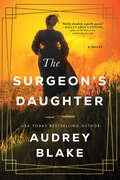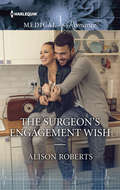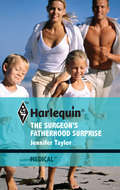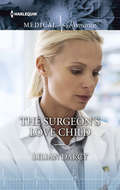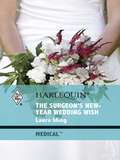- Table View
- List View
The Student's Guide to Cognitive Neuroscience
by Jamie WardReflecting recent changes in the way cognition and the brain are studied, this thoroughly updated fourth edition of this bestselling textbook provides a comprehensive and student-friendly guide to cognitive neuroscience. Jamie Ward provides an easy-to-follow introduction to neural structure and function, as well as all the key methods and procedures of cognitive neuroscience, with a view to helping students understand how they can be used to shed light on the neural basis of cognition. The book presents a comprehensive overview of the latest theories and findings in all the key topics in cognitive neuroscience, including vision, hearing, attention, memory, speech and language, numeracy, executive function, social and emotional behavior and developmental neuroscience. Throughout, case studies, newspaper reports, everyday examples and studentfriendly pedagogy are used to help students understand the more challenging ideas that underpin the subject. New to this edition: Increased focus on the impact of genetics on cognition New coverage of the cutting-edge field of connectomics Coverage of the latest research tools including tES and fNIRS and new methodologies such as multi-voxel pattern analysis in fMRI research Additional content is also included on network versus modular approaches, brain mechanisms of hand-eye coordination, neurobiological models of speech perception and production and recent models of anterior cingulate function. Written in an engaging style by a leading researcher in the field and presented in full color including numerous illustrative materials, this book will be invaluable as a core text for undergraduate modules in cognitive neuroscience. It can also be used as a key text on courses in cognition, cognitive neuropsychology, biopsychology or brain and behavior. Those embarking on research will find it an invaluable starting point and reference. This textbook is supported by an extensive companion website for students and instructors, including lectures by leading researchers, links to key studies and interviews, interactive multiple-choice questions and flashcards of key terms.
The Student's Guide to Cognitive Neuroscience
by Jamie WardReflecting recent changes in the way cognition and the brain are studied, this thoroughly updated fifth edition of this bestselling textbook provides a comprehensive and student-friendly guide to cognitive neuroscience. Jamie Ward provides an easy-to-follow introduction to neural structure and function, as well as all the key methods and procedures of cognitive neuroscience, with a view to helping students understand how they can be used to shed light on the neural basis of cognition.The book presents a comprehensive overview of the latest theories and findings in all the key topics in cognitive neuroscience, including vision, hearing, attention, memory, speech and language, executive function, social and emotional behavior, and developmental neuroscience. Throughout, case studies, newspaper reports, everyday examples, and student-friendly pedagogy are used to help students understand the more challenging ideas that underpin the subject. This edition features expanded coverage of consciousness, a combined chapter on literacy and numeracy, and increased coverage of brain networks and computational approaches.Written in an engaging style by a leading researcher in the field and presented in full color including numerous illustrative materials, this book will be invaluable as a core text for undergraduate modules in cognitive neuroscience. It can also be used as a key text on courses in cognition, cognitive neuropsychology, biopsychology, or brain and behavior. Those embarking on research will find it an invaluable starting point and reference.This textbook is supported by an extensive collection of free digital resources for students and instructors, including lectures by leading researchers, links to key studies and interviews, multiple-choice questions, and interactive flashcards to test your knowledge. Visit the Instructor & Student Resources website at routledgelearning.com/wardcognitiveneuroscience.
The Study of Anatomy in Britain, 1700–1900 ("The Body, Gender and Culture" #13)
by Fiona HuttonHutton looks at Manchester and Oxford to provide a comparative history of anatomical study. Using the Anatomy Act as a focal point, she examines how these two cities dealt with the need for bodies over two centuries.
The Study of Violent Crime: Its Correlates and Concerns
by Cliff Roberson Scott MireViolence is a complex subject that is rooted in a multitude of disciplines, including not only criminology but also psychology, sociology, biology, and other social science disciplines. It is only through understanding violence as a concept that we can hope to respond to it appropriately and to prevent it. The Study of Violent Crime: Its Correlates
The Subculture of Violence: Towards an Integrated Theory in Criminology
by Marvin E. Wolfgang Franco FerracutiTavistock Press was established as a co-operative venture between the Tavistock Institute and Routledge & Kegan Paul (RKP) in the 1950s to produce a series of major contributions across the social sciences. This volume is part of a 2001 reissue of a selection of those important works which have since gone out of print, or are difficult to locate. Published by Routledge, 112 volumes in total are being brought together under the name The International Behavioural and Social Sciences Library: Classics from the Tavistock Press. Reproduced here in facsimile, this volume was originally published in 1967 and is available individually. The collection is also available in a number of themed mini-sets of between 5 and 13 volumes, or as a complete collection.
The Subtle Beast: Snakes, From Myth to Medicine
by Andre MenezThe Subtle Beast: Snakes, from Myth to Medicine introduces you to the complex and absorbing world of these mysterious creatures. Each of the fourteen chapters in this volume can be read independently, but read together they trace a fascinating journey from the macroscopic features of snakes to the molecular description of their venom components. <B
The Successful Health Care Professional’s Guide: Everything You Need to Know But Weren’t Taught in Training
by Todd J. Albert Philip K. Louie Michael H. McCarthyThe goal of this concise guide is to provide a resource of “non-medical” skills and practices that have been shown to help healthcare trainees reach their peak performance. There are many aspects of the healthcare education and training process that are necessary for excelling, preparing for the next stage, and thriving at the level of the trainee’s end goal. However, certain additional skills and principles are essential in reaching peak performance during training, career, and life. Often overlooked in formal training, these skills and principles can be found in a range of areas, including leadership, goal-setting, mentorship, relationships, skills-training, stoicism, and financial planning, to name just several. All are critical in medical-career development, but learning these skills and principles often requires searching through numerous resources to aquire the needed information. Having completed the rigorous training involved in these professions, the accomplished chapter authors of this easy-to-read title offer insightful key points and tangible action items in each section, geared specifically to the trainee and their training education. In addition, authors from various non-medical sectors and professional backgrounds have contributed their expertise to this compendium, giving the book important interdisciplinary coverage. An invaluable and timely contribution to the health career development literature, The Successful Health Care Professional’s Guide will be of great interest to medical students, residents, fellows and all allied health professionals looking to develop the most successful and fulfilling career possible.
The Successful Occupational Therapy Fieldwork Student
by Karen SladykThe Successful Occupational Therapy Fieldwork Student is a stimulating new book that paves the way to the profession of occupational therapy. This book fulfills the needs of all OT and OTA students throughout their entire education by fully preparing them for their fieldwork assignments. This is an imperative learning tool for all students since all curricula include Level I and II fieldwork requirements, ranging from the associate’s level to a master’s program.This complete fieldwork book contains a wide array of topics that guide the reader from the initial planning steps to the completion of successful fieldwork, including how to design fieldwork as a supervisor. It provides students with the opportunity to not only assess various situations, but also utilize their knowledge to demonstrate clinical reasoning. A multitude of activities are included from the first page to the last, designed to groom students for their fieldwork.The Successful Occupational Therapy Fieldwork Student is the ultimate resource for OT/OTA students and the clinicians who educate them, providing a wealth of information while allowing for clinical reasoning to occur. This one-of-a-kind book contains unique features that will prove beneficial to students at varying degrees of education.Features: Each chapter includes activities and assignments for students to complete as they prepare for fieldwork. The text is filled with real-life fieldwork student cases. The text teaches how to prevent problems that can occur, as well as how to fix them when they do.
The Sudden Star
by Pamela SargentFrom a Nebula award-winning author, society turns to violence after a strange celestial body appears in the sky in this dystopian sci-fi thriller. When what appears to be a star turns its powerful and deadly glare toward earth, the entire planet becomes a living nightmare. Rape, murder and suicide become the norm, and fear grips at the heart of humankind. One doctor goes against the tide, defying the medical code by providing insulin to a diabetic. But a protocol that was once a routine part of his practice turns Dr. Simon Negron into a criminal. With a young prostitute as his only ally, he goes on the run through a world that grows madder with every waking hour. . . . Published in the UK under the title The White Death.
The Suffering Animal: Life Between Weakness and Power (The Palgrave Macmillan Animal Ethics Series)
by Simone GhelliThis book provides a critical and innovative reassessment of contemporary debate on the human-animal relationship. Starting with a critique of the “official philosophical narration” of animal studies, and then a reassessment of Descartes' animal-machine paradigm, Simone Ghelli tracks down the conceptual coordinates of what he calls “the paradigm of the suffering animal.” The suffering animal is a materialist thesis on the condition of the living, which, while contesting the metaphysical and anthropocentric structure of western axiology, eventually redefines and re-establishes ethics on the experience of suffering, that is on the mutual compassion sentient beings feel before the unjust sight of their finitude. The suffering animal paradigm shows how, within our philosophical tradition, the animal question has been always intertwined with the questions of atheism and of materialism. The ultimate aim of this research is to define the “ethical equilibrium” between aspects of the living, such as weakness and power, joy and suffering, life and death, which our philosophical tradition largely tends to consider as mutually excluding. To overcome such oppositions means avoiding opposing, in our ethical and political discourse, the defense of the vulnerability of the weak and the freedom of the powerful.
The Suicidal Person: A New Look at a Human Phenomenon
by Konrad MichelKonrad Michel, a leading psychiatrist and acclaimed expert, draws on decades of experience to offer necessary new ways of understanding—and preventing—suicide. After one of his first patients died by suicide, Michel devoted himself to researching self-harm. Writing vividly and personally, he recounts more than forty years of working with and learning from suicidal patients.Michel shows that suicide is not just a consequence of mental illness but an action related to a person’s life story. Drawing on hundreds of interviews with suicidal patients, he argues that suicide and suicide attempts occur when someone experiences extreme emotional pain that severely impairs the ability to think and act rationally. Based on this understanding, Michel and his colleagues developed a person-centered approach to treatment that overcomes the limitations of the traditional medical model. Through a brief therapy, patients find a personally meaningful narrative understanding of their suicidal thoughts and impulses. People at risk can learn to recognize their vulnerabilities in order to manage potentially life-threatening situations and keep themselves safe. Michel emphasizes the importance of communication: medical professionals need to connect with patients as individuals to identify specific warning signs.Both compassionate and rigorous, this book provides vital insight into suicide prevention and shows how changing attitudes will help save lives. It includes practical advice for people at risk, with special emphasis on young people, as well as for relatives and health professionals.
The Summer of Her Baldness: A Cancer Improvisation
by Catherine Lord“No eyebrows. No eyelashes. When it rains the water will run straight down into my eyes,” Catherine Lord wrote before her hair fell out during chemotherapy. Propelled into an involuntary performance piece occasioned by the diagnosis of breast cancer, Lord adopted the online persona of Her Baldness—an irascible, witty, polemical presence who speaks candidly about shame and fear to her listserv audience. While Lord suffers from unwanted isolation and loss of control as her treatment progresses, Her Baldness talks back to the society that stigmatizes bald women, not to mention middle-aged lesbians with a life-threatening disease. In this irreverent and moving memoir, Lord draws on the e-mail correspondence of Her Baldness to offer an unconventional look at life with breast cancer and the societal space occupied by the seriously ill. She photographs herself and the rooms in which she negotiates her disease. She details the clash of personalities in support groups, her ambivalence about Western medicine, her struggles to maintain her relationship with her partner, and her bemusement when she is mistaken for a “sir. ” She uses these experiences—common to the one-in-eight women who will be diagnosed at some point with breast cancer—to illuminate larger issues of gender signifiers, sexuality, and the construction of community.
The Superior Colliculus: New Approaches for Studying Sensorimotor Integration
by William C. Hall Adonis MoschovakisThe Superior Colliculus: New Approaches for Studying Sensorimotor Integration discusses new experimental and theoretical approaches to investigating how the brain transforms sensory signals into the motor commands that are used to shift the direction of gaze. The material includes the potential models for sensorimotor integration in the primate bra
The Surgeon (A Rizzoli & Isles Novel #1)
by Tess Gerritsen<p>He slips into homes at night and walks silently into bedrooms where women lie sleeping, about to awaken to a living nightmare. The precision of his methods suggests that he is a deranged man of medicine, prompting the Boston newspapers to dub him "The Surgeon." <p>Led by Detectives Thomas Moore and Jane Rizzoli, the cops must consult the victim of a nearly identical crime: Two years ago, Dr. Catherine Cordell fought back and filled an attacker before he could complete his assault. Now this new killer is re-creating, with chilling accuracy, the details of Cordell's ordeal. <p>With every new murder he seems to be taunting her, cutting ever closer, from her hospital to her home. And neither Moore nor Rizzoli can protect Cordell from a ruthless hunter who somehow understands--and savors--the secret fears of every woman he kills. <P><b>A New York Times Bestseller</b>
The Surgeon King's Secret Baby
by Amy RuttanA family by New Year’s Eve?Reagan Cote left war-torn Hermosa thinking the gorgeous surgeon she’d shared a brief affair with was lost on the front line. So she clung to the child she was carrying.While Kainan Laskaris’s voice is damaged, he’s alive. And when he finds Reagan in Toronto and discovers he’s dad to their sick baby boy, he asks her to marry him. Now he’s king of Hermosa, he needs a queen and heir, but before she’ll accept, Kainan must prove that marrying Reagan means more than claiming his kingdom.
The Surgeon and the Princess: The Surgeon And The Princess / Captivated By Her Runaway Doc (Mills And Boon Medical Ser.)
by Karin BaineA wounded princess, an off-limits surgeon Can they heal each other?Adjusting to life as an amputee, independent medic Princess Georgiana refuses help from anyone. Yet using surgeon Edward Lawrence&’s state-of-the-art clinic would speed her recovery and escape from the palace for good… Rehabilitation with the gorgeous—and off-limits—Ed means letting her guard down, something Georgiana finds hard… But can Ed make her see just how strong her scars make her and how much she has to offer? &“Reunion with His Surgeon Princess a sweet and exciting royal romance story. Author Karin Baine has a spell-binding way with her writing. I could visualize the story as it unfolded on the pages. She also did a marvelous job of bringing these two characters together for their happy ever after despite their emotional baggage. Highly recommended for all readers of medical romance.&”-Goodreads&“Emotionally enchanting! The story was fast-paced, emotionally charged and oh so satisfying!&”-Goodreads on Their One-Night Twin Surprise
The Surgeon's Baby Bombshell: New York Doc, Thailand Proposal / The Surgeon's Baby Bombshell (Mills And Boon Medical Ser.)
by Deanne AndersOne life-changing night…One longed-for family!He’s gorgeous, dedicated and completely uncompromising! But Dr. Frannie Wentworth knows pediatric surgeon Ian Spencer’s challenging demeanor hides a wealth of pain. And after one heartrending shift on the children’s ward encourages Ian to reveal the grief of losing his son, the friction between them fades…leaving Frannie pregnant! She’s always longed to be a mom, but can she help Ian believe he deserves to embrace fatherhood again?
The Surgeon's Baby Secret
by Amber MckenzieHer baby's daddy... Surgeon Erin Madden never expected to be able to have a baby. And she certainly never expected to fall pregnant from her whirlwind and totally unforgettable romance with Dr. Ryan Callum. But her precious little daughter, Jennie, is proof that dreams can come true... Two years later, and Erin is shocked that Ryan has started work at the same hospital. Things might have ended badly between them, but he still sets Erin's heart racing. And now it's only a matter of time before Ryan discovers her baby secret...
The Surgeon's Baby Surprise
by Charlotte HawkesDiscovering his secret child! For committed surgeon Max Van Berg, career has always come first. He's only ever risked distraction once-during his whirlwind affair with stunning psychiatrist Evangeline Parker... But now Evie's unexpected reappearance has turned Max's world upside down. Not only is Evie battling illness, but she's been forced to keep an even bigger secret from the surgeon! Against all odds Max is a father, and suddenly his sole focus is fighting for Evie, for baby Imogen and for the family he never knew he wanted until now...
The Surgeon's Convenient Husband: The Sheikh Doc's Marriage Bargain / The Surgeon's Convenient Husband (Harlequin Lp Medical Ser. #Vol. 1030)
by Amy RuttanSurprise reunion……with her husband!Dr. Ruby Cloutier agreed to a marriage with army doc Aran Atkinson in name only so she could continue working in Alaska. Aran’s military service has suitably kept them apart—and their attraction at bay—until he unexpectedly returns, more brooding and tempting than ever! Now working together on life-threatening cases, it’s getting harder to resist the burning chemistry between them. Suddenly Ruby finds herself inconveniently falling for her convenient husband!“It is an engaging read that I didn’t want to put down. There are so many emotional barriers to this romance and just how they can be overcome make it an enthralling read. I’ll definitely be looking out for more by this author in future and have no hesitation in highly recommending this book to anyone…”— Goodreads on NY Doc Under the Northern Lights“A Date With Dr. Moustakas is a mesmerizing romance filled with emotional intensity and sensuality. Author Amy Ruttan once again astounds her readers with her heart-warming story telling style.”— Goodreads
The Surgeon's Daughter: A Novel
by Audrey BlakeSheReads Best Historical Fiction Of Summer 2022!"This is an intense, suspenseful, and insightful read about the challenges both women and doctors faced in the 19th century…Our heroine rises to the challenge with courage and determination." —Historical Novel SocietyFrom the USA Today bestselling author of The Girl in His Shadow comes a riveting historical fiction novel about the women in medicine who changed the world forever.Women's work is a matter of life and death. Nora Beady, the only female student at a prestigious medical school in Bologna, is a rarity. In the 19th century women are expected to remain at home and raise children, so her unconventional, indelicate ambitions to become a licensed surgeon offend the men around her.Everything changes when she allies herself with Magdalena Morenco, the sole female doctor on-staff. Together the two women develop new techniques to improve a groundbreaking surgery: the Cesarean section. It's a highly dangerous procedure and the research is grueling, but even worse is the vitriolic response from men. Most don't trust the findings of women, and many can choose to deny their wives medical care.Already facing resistance on all sides, Nora is shaken when she meets a patient who will die without the surgery. If the procedure is successful, her work could change the world. But a failure could cost everything: precious lives, Nora's career, and the role women will be allowed to play in medicine.Perfect for book clubs and for fans of Marie Benedict, Tracey Enerson Wood, and Sarah Penner comes a captivating celebration of women healthcare workers throughout history.
The Surgeon's Engagement Wish
by Alison RobertsHe's back...and this time he's perfect! Nurse Beth Dawson has come to the small town of Hereford, New Zealand, for a bit of peace and quiet after a tumultuous time. The last person she expects to meet is Luke Savage--the high-flying, career-minded surgeon she was engaged to years ago. Luke was always determined to be a cardiac surgeon at the top institutions in Europe--so why is he serving this tiny seaside community in rural New Zealand? Eventually, Beth sees Luke has changed; he's mellowed and has realized what's important in life. But will he forgive her for leaving him? And will Beth give Luke the love and commitment he's never stopped wanting?
The Surgeon's Fatherhood Surprise
by Jennifer TaylorA renowned plastic surgeon and one of London's most eligible bachelors, Jack Tremayne lives the VIP life-he works hard and plays hard. But Jack's world is turned upside down when he learns that he is the single father of a three-year-old boy. . . . Jack returns to his Cornish hometown of Penhally Bay with little Freddie, where he finds his life inextricably tangled with that of single mom practice nurse Alison Myers-fiercely independent, she is determined not to fall for the gorgeous doctor's charm. Alison might just be the answer to Jack's prayers-she's fantastic with Freddie. . . and has captured Jack's heart! Soon he begins to wonder if family life might just suit him after all.
The Surgeon's Love-Child
by Lilian DarcyThe sexual attraction was instantaneous. American surgeon Candace Fletcher felt it as soon as Dr. Steve Colton met her off the plane as she arrived down under. He was gorgeous--tanned, lean, muscular Australian male--several years younger than herself. It wasn't long before they were embarking on a passionate affair... Then, just a few months before she was due to return home to America, the bombshell came: she was pregnant...
The Surgeon's New-Year Wedding Wish
by Laura IdingTrauma surgeon Leila Ross's new colleague, emergency doctor Quinn Torres, might be the most arrogant man she's ever met--but he's also the sexiest!Quinn has closed his heart to love. With his little boy to protect, he knows he can't let anyone get too close. But the moment he takes Leila into his arms at their friend's New Year's Eve wedding, he feels a spark between them he just can't ignore. As Leila dances with Quinn she sees something in his eyes that tempts her to take a chance on love one more time. Might her wish for marriage and a family finally come true?
